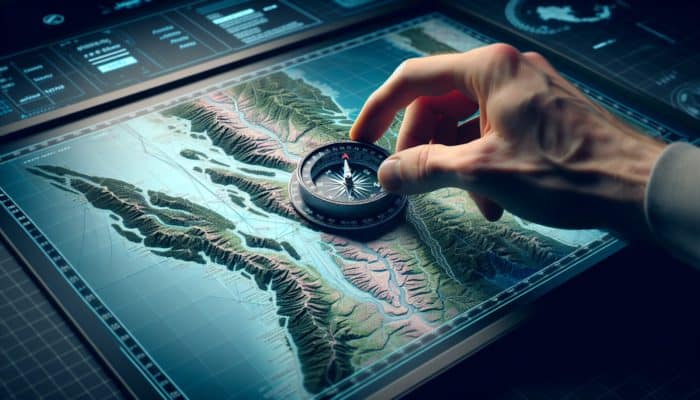Comprehensive Guide to Compass Components and Functionality
What Are the Essential Elements of a Compass?

Compass Reading Basics: A compass serves as a fundamental navigation tool, comprising several critical components that work synergistically to provide accurate directional guidance. Familiarising yourself with these components significantly enhances your navigation skills, whether you find yourself hiking through the rugged mountains, wandering in dense forests, or traversing urban landscapes. Each part of the compass contributes to its overall functionality, making it essential for any outdoor enthusiast or adventurer.
- Magnetic Needle: The magnetic needle is the core component of the compass, capable of freely rotating and aligning itself with the Earth’s magnetic field to point toward magnetic north consistently.
- Housing: The housing acts as a protective casing for the magnetic needle and is often marked with degree measurements to facilitate accurate navigation.
- Baseplate: The baseplate is a transparent platform that allows users to view both the compass and the map simultaneously, greatly enhancing navigation precision.
- Direction-of-Travel Arrow: This arrow indicates the direction you plan to move, ensuring adherence to your intended path.
- Orienting Arrow: Found within the housing, the orienting arrow helps align the compass with the north indicated on a map for accurate directional readings.
- Compass Rose: The compass rose is a circular illustration on the housing showcasing cardinal directions (North, South, East, West) and degree markings, serving as a crucial reference for navigation.
- Index Line: The index line is a reference line that aids in taking precise bearings by aligning it with the direction-of-travel arrow.
Each component plays a significant role in ensuring the compass operates effectively. Recognising how these elements interact with one another allows you to maximise the utility of your compass, whether you are hiking in the majestic Andes, sailing the tranquil waters of the Mediterranean, or navigating through the lush forests of Southeast Asia.
How to Hold Your Compass for Optimal Accuracy
Properly holding a compass is crucial to obtaining reliable readings. Adopting the right technique guarantees that the magnetic needle can move freely without interference from your hand or the surrounding environment. To hold your compass correctly, adhere to these straightforward guidelines.
Begin by ensuring that your compass lies flat in your palm. The baseplate should remain stable and level to minimise any disruptions that could impact the needle’s movement. With the direction-of-travel arrow pointing away from you, use your thumb to stabilise the baseplate while your fingers grip the sides for support. This grip is essential for maintaining a steady hold, which is vital for accurate navigation.
Maintaining a horizontal position is equally important. If the compass tilts, it may lead to incorrect readings. For instance, if you are navigating a rocky path in the Rocky Mountains, ensure your compass is kept level to obtain precise bearings.
In areas with rapid temperature variations, such as high-altitude regions, be mindful of your compass's sensitivity. Cold weather can slow the needle's response, while warm conditions may create air pockets that disrupt accuracy. Always take the time to hold your compass correctly, especially in challenging environments.
The Significance of the Magnetic Needle in Navigation
The magnetic needle is the focal point of the compass, essential for successful navigation. It aligns with the Earth's magnetic field, providing critical orientation as you traverse different terrains. Understanding the behaviour of the magnetic needle is pivotal to successful navigation, whether you are trekking along the Appalachian Trail or exploring the arid deserts of Namibia.
The magnetic needle operates under the influence of the Earth’s magnetic field, which can vary in intensity and direction depending on your geographical location. This variance is why it is vital to understand your surroundings; what works in one region may not be applicable in another. For example, in the Northern Hemisphere, the needle points towards magnetic north, which can differ from true north depending on your precise location.
When navigating, it is also crucial to consider how nearby magnetic objects can affect the needle's response. Metal structures, electronic devices, and other compasses can distort the reading. To counteract this, always take readings away from potential sources of magnetic interference, particularly in urban environments like New York City or during outdoor activities in heavily wooded areas.
Effectively utilising the magnetic needle requires regular practice and awareness. Engaging in compass reading exercises, such as orienteering events held worldwide, will enhance your instinctive understanding of the needle's behaviour and improve your overall navigational abilities.
How to Correctly Orient Your Compass Using a Map

Orienting your compass with a map is a foundational skill for effective navigation. This process ensures that your map is accurately aligned with the terrain you are traversing, allowing for more precise direction-setting. Here’s a step-by-step guide to doing this efficiently.
Start by laying your map flat on a stable surface or holding it directly in front of you. Position the compass along the edge of the map so that the direction-of-travel arrow points towards the top of the map, which typically indicates north. Once in position, rotate both the map and the compass together until the magnetic needle aligns with the orienting arrow inside the compass housing. This alignment confirms that your map is oriented accurately to the real world, whether you are hiking along the coastal trails of the Pacific Northwest or navigating the bustling streets of Tokyo.
Once oriented, you can utilise the compass to take bearings for specific points marked on the map. For instance, if you’re trekking in the breathtaking Swiss Alps and wish to reach a specific summit, locate the summit on your map, align the compass with the direction-of-travel arrow, and note the bearing to guide your journey.
Revisit this orientation process whenever you change locations or encounter significant topographical changes. Reorienting your compass is crucial for maintaining accuracy, especially in challenging environments such as dense forests or mountainous areas where landmarks are scarce.
Understanding Declination and Its Navigational Significance
Declination refers to the angular difference between true north and magnetic north, a vital factor in ensuring accurate compass readings. Grasping how to adjust for declination is essential for enhancing your navigational precision across diverse locations worldwide.
Magnetic declination varies by region and is subject to change over time due to shifts in the Earth’s magnetic field. For instance, in certain parts of the United States, declination can reach several degrees east or west, while in select areas of Europe, it might be almost negligible. To determine your local declination, consult a compass declination chart or utilise online resources that provide updated information based on your coordinates.
To adjust for declination, first, ascertain whether to add or subtract degrees based on your location's declination value. If the declination is east, you will add the degrees to your compass reading; if it is west, you will subtract. For example, if you're navigating near the coast of California and the declination indicates an east deviation of 10 degrees, you would add that to your bearing for precise navigation.
Failing to account for declination could lead to significant navigational errors, particularly in remote wilderness areas where even a minor inaccuracy can result in becoming lost. Regularly recalibrating your understanding of declination based on current maps will ensure you maintain accuracy in your compass readings, whether traversing the rugged landscapes of Patagonia or the expansive plains of Mongolia.
Expert Strategies for Mastering Compass Reading
What Techniques Do Navigation Experts Employ for Accurate Compass Reading?

Experts in navigation utilise a variety of techniques designed to enhance the accuracy of compass readings, thereby ensuring confident traversal through diverse landscapes. Two of the most effective methods are triangulation and backbearing, both of which are crucial for precise navigation.
Triangulation involves taking bearings from two or more identifiable landmarks. By pinpointing these reference points and measuring the angles between them using your compass, you can accurately determine your exact location on a map. For example, while hiking through the Andes, if you identify three distinct peaks, take bearings to each peak and plot them on your map. The intersection of these bearings will reveal your precise location, a valuable technique in scenarios where traditional landmarks are obscured or less visible.
Another essential technique, back-bearing, enables navigators to verify their current course. To perform a back-bearing, take the bearing you just travelled and add or subtract 180 degrees to identify the direction from which you came. This method proves particularly useful in dense environments such as jungles or urban settings, where retracing your steps can help verify your navigational accuracy.
Mastering these techniques requires practice, but they significantly bolster your ability to navigate complex terrains. Regularly participating in activities like orienteering or wilderness survival courses can provide invaluable real-world experience, further solidifying these expert techniques in your navigation toolkit.
How Can You Enhance Your Compass Reading Skills?
Improving your compass reading skills is a systematic process that combines practice, understanding, and exposure to diverse environments. Whether you are gearing up for a hiking expedition in the Alps or an orienteering event closer to home, following structured steps can elevate your proficiency.
One effective method for enhancing your skills is to practice regularly in various environments. Choose different terrains, such as forests, urban areas, or mountainous landscapes, and use your compass to navigate. This exposure helps you become familiar with how environmental factors influence compass readings and allows you to adapt your approach effectively.
Engaging in navigation challenges can also serve as a useful practice. Set specific goals, such as locating a hidden checkpoint within a designated area using only your compass and map, or participating in local orienteering events. These challenges compel you to apply your compass skills under pressure, reinforcing your capabilities and boosting your confidence.
In addition to hands-on practice, studying various navigational techniques can enhance your skills. Explore literature or attend workshops led by experienced navigators, focusing on advanced topics such as declination adjustments and environmental influences on compass readings. Seeking mentorship from seasoned navigators can provide personalised feedback, further refining your understanding and application of compass reading.
Ultimately, improvement stems from a combination of regular practice, exposure to diverse navigational scenarios, and continuous learning. Over time, you will become more proficient and confident in using your compass, whether navigating through the vast landscapes of Australia or the intricate trail systems of the Scottish Highlands.
Advanced Features of Compasses and Their Practical Uses
Modern compasses are equipped with an array of advanced features designed to enhance navigational accuracy, particularly in challenging conditions. Familiarising yourself with these features can significantly elevate your navigation skills, whether you're exploring the rugged terrain of the Rockies or sailing the open seas.
One notable feature is adjustable declination, allowing you to set your compass according to the specific declination of your location. This function is invaluable for those who frequently travel or navigate across different regions, as it eliminates the need for manual adjustments each time bearings are taken.
Another essential feature found in many modern compasses is luminous markings, which provide visibility in low-light conditions. This is particularly beneficial for night navigation or during foggy conditions, ensuring you can read your compass accurately despite environmental challenges. Additionally, some compasses come with built-in clinometers, which measure the angles of slope. This feature is especially advantageous for hikers and climbers who need to assess the steepness of the terrain before traversing.
Another advanced feature is the sighting scope, typically found in more specialised compasses. This allows for precise bearings on distant landmarks by aligning them with the direction-of-travel arrow. Such precision becomes critical when navigating vast wilderness areas or when specific landmarks are scarce and few.
Mastering these advanced features not only enhances your navigation capabilities but also prepares you for unexpected challenges. Familiarising yourself with your compass's capabilities ensures you can maximise the utility of your equipment, whether navigating through the dense jungles of the Amazon or the snow-covered peaks of the Himalayas.
What Common Errors Should You Avoid in Compass Reading?
Navigating with a compass demands meticulous attention to detail, and many novice navigators often encounter common pitfalls that can lead to significant errors. By recognising these mistakes and understanding how to avoid them, you can markedly improve your navigation skills.
One prevalent error is neglecting to account for declination. Failing to account for the angular difference between true north and magnetic north can lead to navigational discrepancies. Always check the local declination and ensure you adjust your compass readings accordingly. This becomes particularly crucial during cross-regional adventures, such as traversing from the east coast to the west coast of the United States, where declination values differ significantly.
Another frequent mistake is misreading bearings. Many users either fail to align the direction-of-travel arrow with the magnetic needle or misinterpret the degree markings. To avoid this, take a moment to double-check your alignment before proceeding, especially in unfamiliar territories such as the winding paths of a national park.
Failing to regularly calibrate your compass, especially after significant use or exposure to potential magnetic interference, is another common error. Always check your compass against known landmarks or reliable tools to ensure it remains accurate.
Finally, neglecting to consider environmental factors can lead to navigation mistakes. Magnetic interference from electronics or metal structures can deflect the needle, impacting your readings. To mitigate this, always conduct readings away from such influences, particularly in urban environments or near large machinery.
By being mindful of these common mistakes, you can navigate with greater confidence and accuracy, whether you are trekking through the Sahara Desert or kayaking in Norway's fjords.
How Do Environmental Factors Influence Compass Readings?
Environmental factors significantly affect the accuracy of compass readings, and understanding these elements is essential for effective navigation. From magnetic interference to terrain features, various conditions can impact how a compass performs in the field.
One major factor is magnetic interference, which can arise from nearby metallic objects, such as vehicles, buildings, or even other navigational tools. In urban settings, such as navigating through a city like Chicago or London, it is crucial to acknowledge that your compass may not provide accurate readings due to these influences. To minimise this risk, always take readings away from potential sources of interference and ensure you are using the compass in an open area.
Terrain can also affect compass readings, particularly in densely wooded areas or mountainous regions where visibility is limited. In such environments, using prominent landmarks can assist in determining your course, but it is equally important to recognise the terrain's impact on your compass. For example, steep slopes may create angles that alter your perception of direction, making it challenging to follow a straight bearing. Techniques such as pacing can help counteract these challenges, allowing you to maintain your intended course.
Weather conditions can further complicate compass readings. Heavy rain, snow, or fog can obscure visibility and hinder landmark identification. In these scenarios, rely on a compass with luminous features for better visibility and take frequent bearings to ensure you remain on course.
Understanding how these environmental factors impact compass performance allows you to adapt your navigational strategies effectively. Whether you are navigating through the canyons of the Grand Canyon or the rainforests of Costa Rica, being aware of these influences ensures your compass remains a reliable navigational tool.
Mastering the Art of Taking Accurate Compass Bearings
What Is a Compass Bearing and How to Take One?
A compass bearing represents the direction you intend to travel, expressed in degrees from true north. Accurately taking a bearing is fundamental for effective navigation, whether you are hiking through the Appalachian Mountains or sailing across the open waters of the Caribbean.
To take an accurate bearing, follow these steps:
- Select Your Landmark: Identify a distinct landmark that you can easily see in the distance to aim at.
- Align the Compass: Hold the compass flat and point the direction-of-travel arrow towards the landmark.
- Read the Bearing: Rotate the compass housing until the magnetic needle aligns with the orienting arrow, then read the degree at the index line.
- Record the Bearing: Ensure you note down the bearing for reference as you navigate.
Taking an accurate bearing requires both practice and patience. For example, if you are navigating through the dense forests of British Columbia, identifying a visible peak or distinctive tree can greatly aid you. Ensure that you take your time to align the compass correctly and verify the reading before proceeding.
Regular practice in various environments will enhance your ability to take bearings quickly and accurately. Engaging in activities like geocaching, which often combines compass use with treasure hunting, allows you to hone these skills while enjoying the outdoors.
The process of taking bearings becomes especially crucial when navigating unfamiliar terrain or in emergencies. Knowing how to quickly and accurately set a course can help prevent disorientation and ensure a safe arrival at your destination.
Setting Bearings Using Landmarks Effectively
Utilising landmarks to set bearings is an effective navigational strategy that merges visual references with compass readings. When executed correctly, this method enables you to maintain your course even in environments where traditional navigation tools may be less reliable, such as dense forests or unfamiliar urban areas.
Begin by selecting a prominent landmark in the distance, such as a mountain peak, a distinctive tree, or an identifiable building. Hold your compass flat, pointing the direction-of-travel arrow towards this landmark. This alignment is crucial; it constitutes the first step in establishing an accurate bearing. As you align your compass, ensure that the magnetic needle is properly oriented with the compass housing, reflecting the true north direction.
After aligning your compass, read the bearing at the index line. This degree measurement tells you the direction to travel to reach your landmark. For instance, if you are navigating through the Sahara Desert and spot a distant oasis, use that landmark to set your bearing and maintain your direction as you proceed.
Employing landmarks becomes even more critical in low-visibility conditions, where features may be obscured, making it essential to use them effectively. In such cases, taking multiple bearings from different landmarks can help triangulate your position. This triangulation method aids navigation through challenging environments, ensuring you remain oriented even when visibility is compromised.
Regular practice of these techniques in various settings, such as during hikes or urban exploration, will enhance your ability to employ landmarks as reliable navigational aids. The combination of visual references and compass readings will significantly enhance your navigation skills, whether you are trekking through the Canadian wilderness or exploring the ancient streets of Rome.
Adjusting for Magnetic Declination: A Key Skill
Adjusting for magnetic declination is a critical aspect of accurate compass navigation. This adjustment compensates for the difference between true north and magnetic north, which varies depending on your geographical location. Understanding how to make this adjustment ensures that your compass readings remain precise, regardless of where you are navigating.
To begin, determine the local magnetic declination for your area. This information can be found on various online resources or by consulting local maps that indicate declination values. For instance, if you are navigating in northern Scandinavia, the declination might be several degrees east or west, depending on your exact position.
Once you have established the declination, the adjustment process is straightforward. If the declination is east, you will add the degrees to your compass bearing; if it is west, you subtract. For example, if you are hiking through the Alps and your bearing is 45 degrees, but the declination indicates 10 degrees east, your adjusted bearing will become 55 degrees.
It is essential to apply this adjustment consistently throughout your navigation to maintain accuracy. Regularly recalibrating your knowledge of local declination is particularly important when travelling across regions with varying declination values. For instance, a trek from the American Midwest to the West Coast, where declination values differ significantly, necessitates careful consideration to ensure you do not inadvertently veer off course.
Understanding and applying magnetic declination adjustments is vital for successful navigation. It minimises the risk of disorientation and ensures you stay on track, whether navigating through the remote landscapes of New Zealand or the bustling streets of Istanbul.
Practical Navigation with a Compass
How to Follow a Compass Bearing Effectively?
Following a compass bearing is a fundamental skill in navigation, requiring a combination of attention, technique, and practice. Successfully executing this skill enables you to maintain your intended direction, whether you are hiking in the Rockies or sailing across the Atlantic.
To follow a compass bearing, first ensure you have accurately taken your bearing and adjusted for any declination. With the bearing noted, hold your compass flat in your hand, ensuring it remains level. Align the direction-of-travel arrow with your bearing. Once aligned, the magnetic needle should point towards the orienting arrow within the housing.
As you begin to walk, please focus on the direction-of-travel arrow, ensuring it remains aligned with the bearing you set. This practice can be particularly challenging in environments with obstacles, such as dense forests or rocky terrains. In such cases, commit to a fixed point in the distance that aligns with your bearing, allowing you to navigate around obstacles while maintaining your course.
Periodic checks are vital while following your bearing. Regularly glance at your compass to confirm that the needle remains aligned with the orienting arrow. This practice not only ensures you stay on course but also helps you recalibrate if you inadvertently stray from your intended path.
Incorporating additional navigation techniques, such as pacing, can further enhance your ability to follow a bearing. Counting your steps or using a pedometer to measure distance travelled can provide vital feedback for longer treks, ensuring you maintain your direction even in challenging environments like the Amazon rainforest or the winding paths of the Scottish Highlands.
Utilising a Compass in Conjunction with a Map
Combining a compass with a map is a powerful navigational strategy that significantly enhances your ability to traverse various terrains effectively. This technique allows for a more comprehensive understanding of your surroundings, transforming your navigation experience, whether you are venturing through the wilds of Alaska or exploring the terrain of the Scottish Highlands.
To begin using both tools, lay your map flat in front of you and orient it properly using your compass. Align the compass along the edge of the map, ensuring the direction-of-travel arrow points toward the top of the map, denoting north. Once the two are aligned, rotate both the map and the compass until the magnetic needle aligns with the orienting arrow within the compass. This ensures that your map accurately reflects the actual terrain layout.
Once the map is oriented, use the compass to take bearings on specific points of interest, such as a mountain peak, a lake, or a notable trail junction. For example, while hiking in the Rocky Mountains, if you identify a visible peak, take a bearing and translate that information onto your map, marking the route you intend to follow.
Regularly consult your compass while navigating to ensure you remain on course. As you progress, check off landmarks and points of interest on your map, reinforcing your understanding of your location about your surroundings. This practice becomes crucial in unfamiliar environments, where terrain features may be deceptive, such as navigating through the dense canopies of a tropical rainforest or the vast open plains of the Serengeti.
Ultimately, mastering the combination of map and compass navigation enhances your overall outdoor experience. By developing this skill set, you can confidently explore diverse environments and adeptly adjust your route as required, whether you are hiking, backpacking, or engaging in adventure sports around the globe.
What Are Common Navigation Errors to Avoid?
Common navigation mistakes can lead to disorientation and potentially hazardous situations, particularly in unfamiliar environments. By recognising these pitfalls and understanding how to avoid them, you can significantly enhance your navigational skills and overall safety.
One frequent mistake is neglecting to adjust for declination. Many novice navigators fail to account for the local declination value, resulting in significant errors in their readings. Ensure you check the declination for your location regularly and make the necessary adjustments to maintain accuracy.
Another mistake is failing to verify compass readings. Many users take a bearing and start walking without double-checking the alignment of the needle with the orienting arrow. This oversight can lead to undesirable detours. Always confirm that the compass is properly aligned before proceeding; this practice is essential in both forested areas and open landscapes.
Misinterpreting bearings or failing to keep track of your position can lead to significant navigation errors. It is critical to consistently refer to your map and revisit landmarks to ensure you remain aware of your location. For instance, while trekking through the Sahara Desert, relying solely on a compass without frequent verification can lead to misdirection when landmarks are scarce.
Finally, failing to account for environmental factors can create challenges in navigation. Magnetic interference from electronic devices or metal structures can skew compass readings. Always check your surroundings and take readings away from such influences, particularly in urban environments or near heavy machinery.
By being aware of these common navigation mistakes, you can navigate with greater confidence and accuracy. Whether trekking through the Australian Outback or exploring the coastal trails of New Zealand, recognising these pitfalls will help you avoid potential problems and enhance your overall navigation skills.
Essential Compass Maintenance and Care
How to Clean and Store Your Compass Properly
Proper maintenance and care of your compass are vital for its longevity and accuracy. Regular cleaning and appropriate storage practices will ensure that your navigation tool remains reliable, whether you are hiking in the mountains or sailing on the open sea.
Start by cleaning your compass periodically to remove dirt, dust, and moisture that can accumulate over time. Use a soft, lint-free cloth to gently clean the exterior, being careful not to scratch the glass or plastic. If the interior has become foggy or dirty, it is essential to follow the manufacturer’s guidelines for cleaning to avoid damage.
When storing your compass, select a cool, dry location away from potential sources of magnetic interference, such as electronic devices or metal objects. Avoid leaving your compass in direct sunlight or extreme temperatures, as this can damage its internal mechanisms and affect accuracy. For instance, storing your compass in a protective case or pouch can help shield it from environmental factors and prolong its lifespan.
In addition to regular cleaning, conducting periodic checks on your compass's accuracy is essential. Take it out during hikes or outdoor activities to ensure the needle responds correctly to magnetic north. If you notice any discrepancies, it may be time to recalibrate or seek professional assistance.
Ultimately, diligent care and maintenance of your compass will ensure it remains a trustworthy tool for navigation. Whether you are exploring the rugged terrain of Patagonia or navigating the serene waters of the Bahamas, a well-maintained compass will greatly enhance your outdoor experiences.
What Steps Should You Take If Your Compass Malfunctions?
Compass malfunctions can occur for various reasons, and understanding how to address these issues is crucial for effective navigation. Understanding the signs of malfunction and the steps to take can ensure you remain oriented, whether in a remote wilderness or familiar terrain.
If you suspect your compass is malfunctioning, begin by checking for nearby magnetic interference. Common sources include electronic devices, vehicles, or metal structures that can distort the magnetic needle’s response. Move away from potential interference and retest your compass to see if accuracy is restored.
Physical damage to the compass can also lead to malfunctions. Inspect the housing for cracks or other signs of wear that may affect performance, and ensure the needle moves freely within the housing. If you notice any physical damage, it may be necessary to recalibrate the compass or consider replacing it.
In instances where the compass remains unresponsive or inaccurate after checking for damage and interference, consider consulting a professional for calibration. Many outdoor equipment shops or navigation specialists offer calibration services, ensuring your compass functions optimally.
Ultimately, knowing how to troubleshoot compass malfunctions is essential for maintaining navigational accuracy. Whether you’re exploring the lush landscapes of Costa Rica or the rugged mountains of Alaska, having a reliable compass is crucial for safely reaching your destination.
How to Protect Your Compass in Harsh Conditions
Navigating in harsh conditions presents unique challenges that can negatively impact the performance and longevity of your compass. Understanding how to protect your compass during extreme weather or environmental conditions is crucial for ensuring it remains a reliable navigational tool.
Extreme temperatures, whether cold or sweltering heat, can affect a compass's accuracy. If you are navigating in frigid conditions, such as the Arctic tundra, keep your compass close to your body to maintain its temperature. In warm environments, such as deserts, avoid leaving your compass in direct sunlight or a hot vehicle, as high temperatures can distort the internal components.
Moisture is another significant factor that can damage a compass. If you are navigating through rainy or humid conditions, invest in a waterproof compass or use a protective case to shield your instrument from moisture. For example, while kayaking along the coast of New Zealand, a waterproof compass can ensure you stay on course despite splashes and rain.
In windy conditions, secure your compass to prevent it from being knocked over or lost. If you are navigating in mountainous terrains where strong winds are common, consider using a lanyard to attach the compass to your gear, ensuring it remains accessible and intact.
Regularly inspect your compass for signs of wear or damage, particularly after exposure to harsh conditions. Maintaining your compass's integrity will help ensure that it remains a reliable tool, whether you are traversing the rugged terrain of the Canadian Rockies or exploring the icy landscapes of Antarctica.
Research-Backed Benefits of Mastering Compass Reading
How Does Compass Reading Enhance Safety in Outdoor Activities?
Compass reading is not merely a navigational skill; it plays a critical role in enhancing safety during outdoor activities. By providing a reliable method of navigation, compass reading minimises the risks of getting lost and ensures that individuals can make informed decisions in emergencies.
One significant benefit of mastering compass reading is its reliability in environments where GPS signals may be unreliable or unavailable. For instance, in remote regions such as the Alaskan wilderness or the dense Amazonian forests, electronic devices may lose signal, rendering them ineffective. In these situations, a compass remains a dependable tool that does not rely on battery power or connectivity, ensuring consistent navigation.
Moreover, compass reading empowers individuals to navigate with confidence, reducing anxiety during outdoor excursions. Whether hiking a trail in the Swiss Alps or camping in the Australian wilderness, being able to determine direction accurately fosters a sense of security. This confidence enables outdoor enthusiasts to explore new terrains while minimising the risk of disorientation or getting lost.
In emergencies, compass reading becomes particularly vital. For example, if hikers find themselves lost in a snowstorm, knowing how to read a compass and identify their direction can significantly enhance their chances of survival. Regular practice in compass navigation equips individuals with the skills to act decisively and effectively in emergencies that affect their safety and security.
Ultimately, the safety benefits of compass reading extend beyond mere navigation. By fostering confidence and ensuring reliability in various conditions, mastering this essential skill can enhance the overall outdoor experience, whether camping in the Oregon wilderness or trekking through the hills of Scotland.
Enhancing Spatial Awareness Through Compass Usage
Using a compass not only aids in navigation but also significantly enhances spatial awareness. This skill enables individuals to understand their position about their surroundings, which is crucial for effective navigation and overall safety.
When engaging with a compass, individuals develop a greater understanding of geography, topography, and directional orientation. For example, as you navigate through the dense foliage of a rainforest, using a compass helps you visualise your position relative to nearby landmarks and trails. This understanding fosters an innate sense of direction, enabling you to make informed decisions about future routes.
Moreover, regularly practicing compass navigation reinforces the brain's ability to process spatial information. Studies indicate that activities involving spatial reasoning, such as navigation with a compass, can enhance cognitive abilities. As you become more adept at interpreting compass readings and orienting yourself in various environments, you strengthen your spatial awareness and problem-solving skills.
Practicing compass navigation also encourages individuals to engage more deeply with their environment. By actively using a compass, you become more attuned to the geographical features around you, such as hills, valleys, rivers, and other significant landmarks. This heightened awareness not only enhances your navigation skills but can also enrich your overall outdoor experience.
Ultimately, using a compass enhances spatial awareness, contributing to a deeper understanding of your surroundings and improving your navigation capabilities. Whether you are hiking in the picturesque fjords of Norway or exploring the rugged terrain of New Zealand, mastering compass reading allows you to connect even deeper with the environment.
What Cognitive Benefits Are Associated with Compass Reading?
Engaging in compass reading presents several cognitive benefits, enhancing mental abilities such as memory, problem-solving, and critical thinking. Regular practice of this skill fosters cognitive development that extends beyond navigation to various aspects of life.
One of the primary cognitive benefits of compass reading is improved memory. Remembering bearings, landmarks, and directional cues requires mental effort and reinforces memory retention. As you practice navigating with a compass, you train your brain to recall information effectively, which can enhance overall cognitive function.
Moreover, compass reading encourages problem-solving skills. Navigating unfamiliar terrains often presents challenges, such as finding alternative routes or adjusting for environmental factors. Learning to overcome these challenges fosters critical thinking and adaptability. For instance, if you are trekking in the Himalayas and encounter unexpected weather changes, knowing how to read your compass and adjust your course enhances your ability to problem-solve in real-time.
Additionally, engaging in compass navigation promotes attention to detail. Successfully navigating requires a keen awareness of your surroundings, ensuring you remain conscious of changes in terrain, landmarks, and other navigational cues. This heightened attention to detail transfers to other areas of life, improving focus and concentration.
Overall, the cognitive benefits of compass reading extend beyond navigation. By enhancing memory, problem-solving skills, and attention to detail, mastering this skill contributes to a more well-rounded cognitive capability. Whether you are hiking in the scenic landscapes of Patagonia or exploring the cultural richness of Southeast Asia, the impact of compass reading resonates with your overall cognitive development.
Navigating with a Compass in Various Conditions
How to Navigate Effectively in Low Visibility?
Navigating in low visibility conditions, such as fog, rain, or darkness, presents unique challenges that require specific strategies to ensure successful compass navigation. Employing techniques that adapt to these circumstances enables individuals to maintain direction and safety, regardless of external conditions.
In low visibility situations, using a compass with luminous markings can significantly enhance your ability to read it effectively. Such compasses allow you to take bearings even when visibility is compromised, as they illuminate in low light. For example, during a nighttime hike in a national park, a luminous compass can be invaluable, allowing you to navigate while enjoying the beauty of the starlit sky safely.
When navigating in dense fog or heavy rain, take frequent bearings to confirm your direction and ensure accuracy. As visibility decreases, regularly checking your compass helps maintain your course and prevents disorientation. Moving from one identifiable landmark to another, even if they are not immediately visible, serves to reinforce your navigation strategy. For instance, if traversing a foggy coastal path, aim for a distant rock formation or tree that you can periodically check against your compass readings.
Another effective technique is to employ pacing to measure distance travelled. In low visibility, it can be easy to lose track of how far you've come. By counting your steps and estimating the distance based on your pace, you can better gauge your progress and adjust your compass readings accordingly.
Ultimately, mastering navigation in low visibility conditions requires practice and adaptability. Engaging in exercises that simulate these challenges enhances your confidence and skill set, ensuring that you can navigate the unpredictable environments of the world effectively.
What Techniques Are Effective in Rough Terrain Navigation?
Navigating through rough terrain presents unique challenges that necessitate specific techniques to maintain accuracy and efficiency. Whether traversing rocky mountain paths, rugged hills, or uneven forest floors, employing effective strategies can significantly enhance your navigational experience.
Pacing is a critical technique for navigating rough terrain. By counting steps, you can measure distance and ensure you maintain your course, even when visibility is compromised or the path is less clear. For instance, when hiking a rocky trail in the Tetons, counting your paces can help you gauge how far you've travelled, allowing you to adjust your compass readings as necessary.
Utilising landmarks effectively becomes even more important in challenging environments. In rugged terrain, identifiable features such as rock formations, unique trees, or other distinctive landmarks can serve as navigational aids. Aligning your compass with these features not only helps set bearings but also reinforces your understanding of your surroundings.
When navigating steep or uneven terrain, take a moment to assess your surroundings regularly. As you move, check your compass frequently to ensure you remain on course. Adjust your heading as necessary to accommodate obstacles, such as boulders or fallen trees, which may hinder a straight path.
Lastly, always be prepared for sudden changes in terrain. Whether you’re navigating through a rocky landscape in Patagonia or dense underbrush in the Amazon, maintaining flexibility in your approach is vital. This adaptability not only enhances navigational accuracy but also ensures you can remain oriented and reach your destination safely.
By employing pacing, effectively using landmarks, and remaining adaptable to terrain changes, you can navigate confidently through rough environments. These techniques become invaluable for outdoor adventures, whether you are climbing in the Andes or exploring the backcountry of New Zealand.
Utilising a Compass in Water-Based Activities
Compasses are not only useful on land; they are equally vital for navigation in water-based activities, such as kayaking, sailing, or fishing. Understanding how to use a compass in aquatic environments effectively ensures safe and accurate navigation, whether you're paddling through a lake in Canada or sailing on the open sea.
When engaging in water-based navigation, it is essential to ensure that your compass is waterproof or securely protected from splashes. A waterproof compass is designed to withstand exposure to water, allowing you to navigate confidently in rain or while on the water. For example, if you are kayaking along the coast of Maine, a waterproof compass ensures that you can take bearings without worrying about damage from waves or rain.
When taking bearings while on the water, hold the compass level and align it with your intended direction of travel. Keep the compass steady to ensure the magnetic needle can respond accurately. If navigating in currents or waves, be prepared for the needle to sway; in these situations, taking multiple readings can help confirm your course.
Another consideration is understanding the effects of wind and current on your navigation. These factors can affect your trajectory, making it essential to adjust your compass readings accordingly. For instance, if you are sailing on a windy day, it may be necessary to compensate for drifting caused by strong gusts or currents to maintain your intended heading.
Regularly practice using a compass while engaging in water-based activities. As you navigate different bodies of water, familiarise yourself with how environmental elements affect your compass readings. This preparation becomes invaluable for extended excursions, whether sailing across the Caribbean Sea or kayaking in Norway's fjords.
Ultimately, effectively using a compass in water-based activities enhances navigation and safety, ensuring that you can confidently explore and enjoy aquatic environments, whether fishing in a river or sailing the open seas.
How to Navigate in Extreme Weather Conditions Using a Compass?
Navigating in extreme weather conditions poses unique challenges that can affect compass accuracy and reliability. Understanding how to adapt your compass use in these environments is essential for ensuring safe and effective navigation, whether you are hiking in icy temperatures or navigating through heavy rain.
In cold weather, keeping your compass warm is crucial to maintaining accuracy. As temperatures drop, the magnetic needle can become sluggish, making it difficult to obtain reliable readings. Carry your compass close to your body when not in use to keep it warm, particularly during winter hiking excursions in the Alps or Arctic regions.
In heavy rain or snow, using a waterproof compass is vital. If your compass is not designed to withstand moisture, consider using a protective case to shield it from the elements. For example, during a snowstorm in the mountains, a waterproof compass will ensure that you can take readings without risking damage.
Additionally, when navigating in extreme conditions, take frequent bearings to confirm your direction and ensure accuracy. Due to poor visibility, you may lose track of your course; regular checks enable you to recalibrate and adjust as necessary. When traversing snow-covered terrain, where landmarks are often obscured, taking consistent bearings can help prevent disorientation.
Lastly, consider environmental factors such as wind or temperature fluctuations that can affect readings. Cold winds may cause the needle to deflect, while rapidly changing conditions can lead to confusion. Always be prepared for sudden changes and regularly consult your compass to ensure you remain oriented.
By understanding these techniques and adapting your compass use to extreme weather conditions, you enhance your navigational skills. Whether trekking through blizzards in the Rockies or facing torrential rain in a tropical environment, mastering these skills ensures that you can safely reach your destination.
Navigating Through Dense Vegetation with a Compass
Navigating through dense vegetation presents unique challenges that require specific techniques for accurate compass reading. In environments where visibility is limited due to thick underbrush or trees, employing effective strategies ensures you can maintain your direction and safely navigate through challenging terrain.
When navigating through dense vegetation, start by identifying prominent landmarks that can serve as guides. Look for distinctive trees, rock formations, or openings in the foliage that can serve as reference points. This practice allows you to use both your compass and visual cues to maintain your course, whether you are hiking through the jungles of Southeast Asia or the forests of North America.
To take bearings effectively in dense vegetation, use a sighting compass if available. This type of compass enables you to align with distant landmarks while also taking accurate readings. To do this, point the direction-of-travel arrow at your chosen landmark while ensuring the magnetic needle aligns with the orienting arrow. This technique is particularly useful when visibility is limited and you need to confirm your direction against distant features.
Additionally, pacing becomes essential in dense environments. As you navigate, keep track of your steps and use pacing to estimate distances travelled. This method ensures that you remain aware of your progress and allows you to adjust your compass readings accordingly, especially in areas where landmarks are difficult to discern.
Lastly, remain adaptable to changing conditions. Dense vegetation can obstruct your view and make navigation challenging; therefore, be prepared to adjust your route as needed. Regularly consult your compass to ensure you remain oriented and adjust your course when necessary.
By employing these techniques, you can navigate effectively through dense vegetation, whether you are exploring the Amazon Rainforest or hiking through the Appalachian Mountains. Mastering these skills enhances your overall navigation experience, enabling you to navigate various environments confidently.
Advanced Techniques for Compass Reading
What Is Triangulation and How Can You Use It?
Triangulation is an advanced navigational technique that enables users to pinpoint their exact location by taking multiple bearings from known landmarks. This method is especially useful in environments where visibility is limited, such as navigating through unfamiliar terrain, like the expansive wilderness of Canada or the rugged peaks of the Swiss Alps.
To effectively utilise triangulation, follow these key steps:
- Identify Landmarks: Choose at least three distinct landmarks that are visible from your current location.
- Take Bearings: Use your compass to take bearings on each landmark, ensuring you adjust for declination if necessary.
- Plot on a Map: Mark each bearing on your map from the corresponding landmark's location to visualise your position.
- Find Intersections: The point where the lines from your plotted bearings intersect indicates your exact location.
For example, if you are exploring the vast landscapes of the Australian Outback, you might identify a prominent rock formation, a distinctive hill, and a water source. After taking bearings from each point, plot them on your map to determine your position relative to these features.
Triangulation not only provides a precise location but also enhances your overall navigation skills. Engaging in this technique regularly reinforces your ability to read compasses accurately and boosts your confidence in navigating challenging terrains.
As you practice triangulation in various environments, such as during orienteering events or wilderness survival courses, you will refine your skills and develop a deeper understanding of how to leverage multiple bearings for accurate navigation.
How to Use Back-Bearing Techniques for Navigation?
Back-bearing is a navigational technique that involves taking a bearing in the opposite direction of your intended route to verify your course. This method is particularly useful for confirming your navigation accuracy and ensuring you remain on track, whether you are exploring the scenic trails of the Appalachian Mountains or the rugged coastlines of New Zealand.
To perform a back-bearing, start by taking a standard bearing to determine your intended direction. Once you have your initial bearing, add or subtract 180 degrees to identify your back-bearing. For example, if your heading is 60 degrees, the back-bearing would be 240 degrees. This reverse bearing provides a reference point for verifying your course.
When navigating, regularly taking back bearings can help confirm your accuracy. For instance, if you have travelled several kilometres on a hiking trail and wish to ensure you are still headed in the right direction, take a back bearing and compare it to your original bearing. If the two readings align, you can proceed with confidence.
In challenging environments, such as dense forests or mountainous terrains, back-bearing becomes even more pivotal. If you suspect you’ve strayed off course, taking a bearing allows you to retrace your steps accurately and avoid getting lost. This technique is especially useful when navigating in regions where landmarks are scarce or visibility is compromised.
Ultimately, mastering the back-bearing technique enhances your navigational skills and builds confidence in your ability to maintain direction. Regular practice in various environments will reinforce your understanding and application of this essential navigational tool, ensuring you can safely navigate diverse landscapes.
How to Combine Compass and GPS for Enhanced Navigation?
Combining a compass with GPS technology enhances navigational accuracy and provides a more comprehensive approach to outdoor navigation. While GPS provides precise location data, a compass offers reliability independent of electronic devices, making the two an ideal pairing for effective navigation.
To effectively combine these two tools, start by using your compass to orient your map. Once you have established your bearings and aligned your map, you can use your GPS device to verify your current position. For example, if you are hiking the Pacific Crest Trail, use your compass to navigate, while your GPS can provide periodic updates on your location.
When using GPS, it is crucial to remain aware of potential signal loss, particularly in remote areas or dense environments such as forests or canyons. In these situations, your compass serves as a reliable backup, ensuring that you can continue to navigate effectively even when the GPS signal is weak or unavailable.
Additionally, using both tools allows you to cross-check information. While the compass provides a general direction, your GPS can offer specific coordinates, enhancing your understanding of your surroundings. Regularly referencing your compass while checking your GPS ensures that you stay oriented, particularly in unfamiliar terrains or during long hikes.
As you practice combining these navigational tools, engage in diversified outdoor activities, such as orienteering or hiking, to strengthen your skills. Navigating with both a compass and GPS ensures you are well-prepared for various environments, whether exploring the breathtaking landscapes of Patagonia or traversing the coastal paths of Maine.
Frequently Asked Questions About Compass Usage
What is the basic function of a compass?
A compass helps determine direction by aligning a magnetic needle with the Earth’s magnetic field, allowing users to navigate accurately.
How do I properly hold a compass?
Hold the compass flat in your hand, with the direction-of-travel arrow pointing away from you, maintaining a level position for accurate readings.
What is magnetic declination?
Magnetic declination is the angle between magnetic north, indicated by the compass, and true north. Adjusting for declination is essential for accurate navigation.
What are common mistakes when using a compass?
Common mistakes include neglecting declination adjustments, misreading bearings, and failing to account for environmental factors that may influence compass readings.
How can I improve my compass reading skills?
Regular practice in various environments, engaging in navigation challenges, and studying advanced techniques can significantly enhance your compass reading skills.
What should I do if my compass malfunctions?
Check for nearby magnetic interference and physical damage. If issues persist, consult a professional for calibration or consider replacing the compass.
How does the weather affect compass navigation?
Extreme weather conditions, such as heavy rain or snow, can obscure visibility and affect compass accuracy. Use protective cases and take frequent readings to stay oriented.
Can I use a compass at sea?
Yes, a compass is essential for navigation in water-based activities. Ensure it is waterproof and take regular bearings to maintain your course.
What is triangulation in compass navigation?
Triangulation involves taking bearings from multiple landmarks to pinpoint your exact location on a map, enhancing navigational accuracy in unfamiliar terrains.
How does using a compass improve cognitive skills?
Compass reading enhances cognitive functions such as memory and problem-solving skills by requiring mental engagement with directional and spatial reasoning.
Explore our world on X!
Navigating Without a Map: Proven Tips for Adventurers
Mastering the Art of Navigation Without a Map What is the core concept behind mapless navigation? Navigating Without a Map: Navigating without a map is a technique that empowers individuals to use their environment to find their way, reducing reliance on GPS or traditional paper maps. This method encourages people to engage with natural landmarks, trust […]
Map Reading Skills: Essential Techniques Unveiled
Mastering the Essential Aspects of Map Reading Decoding Map Symbols for Effective Navigation Map Reading Skills: Effectively reading a map relies heavily on your ability to decode map symbols. These symbols represent a variety of both natural and artificial features, providing vital information essential for navigation and exploration. A thorough understanding of these symbols not […]
Survival Compass Guide: Essential Tips for Navigation
Mastering Compass Navigation: Essential Knowledge and Techniques What is a Compass and Its Importance? Survival Compass Guide: A compass is an indispensable navigational tool that enables individuals to ascertain direction in relation to the Earth's magnetic poles. This device typically features a magnetised needle that consistently points towards magnetic north, facilitating orientation in unfamiliar terrains. […]
Portable Camping Stoves: Your Ultimate Outdoor Cooking Solution
Explore the Diverse Range of Portable Camping Stoves Understanding Canister Stoves for Camping Adventures Portable Camping Stoves: Canister stoves are a popular choice among outdoor enthusiasts. These stoves are designed to be compact and use pre-filled fuel canisters, making them user-friendly and easier to maintain. Whether you are a novice camper or a seasoned adventurer, canister stoves […]







